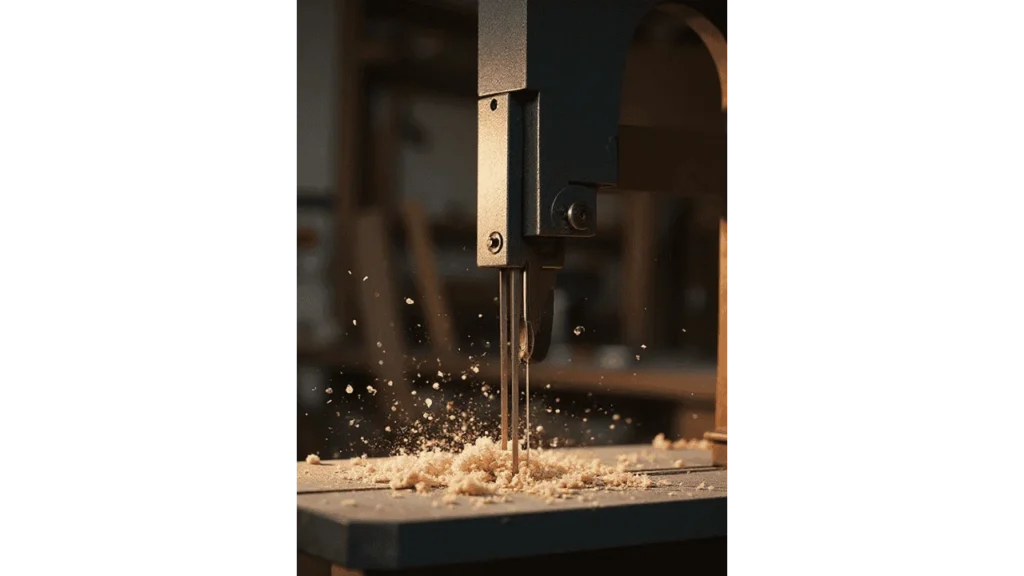Sharpening a bandsaw blade is essential for extending its lifespan and maintaining optimal cutting performance. A dull blade not only produces rough cuts but also places unnecessary strain on your saw’s motor, reducing its efficiency. From my experience, regular sharpening keeps your bandsaw performing like new and ensures precise, clean cuts every time. Proper maintenance is a small investment of time that significantly enhances the tool’s reliability and your project results.

Tools and Materials Needed
Before you begin, make sure you have the right safety gear, including safety glasses, gloves, and hearing protection. For sharpening, you can use a Dremel tool with a cut-off wheel or a diamond card file, depending on your preference and the precision required. Optional tools, like a sharpening jig, can help maintain consistent angles across all teeth, making the process easier and more accurate. Having all these tools prepared ensures a safe, efficient sharpening session.
Step-by-Step Guide to Sharpening a Bandsaw Blade
Step 1: Prepare the Bandsaw
Start by unplugging the saw to ensure there is no power running through it, preventing accidents. Next, clean the blade to remove any debris, resin, or pitch buildup that could interfere with the sharpening process.
“A clean blade allows you to see each tooth clearly and ensures a more even sharpening result,” notes tool technician Sarah Lopez.
Step 2: Inspect the Blade
Carefully examine the blade for any broken or missing teeth. Assess its sharpness to determine whether it needs sharpening or a full replacement. Taking the time to inspect the blade prevents unnecessary effort on damaged teeth that cannot be restored.
Related: How to Change a Bandsaw Blade?
Step 3: Sharpening the Teeth
Using a Dremel Tool
Attach a cut-off wheel to your Dremel tool. Hold the tool at a slight angle to the tooth and gently touch the wheel to the cutting edge, moving along each tooth carefully. Repeat this process for all teeth, maintaining consistent pressure to ensure uniform sharpness.
“Using a Dremel gives precise control, but remember to move slowly and evenly to avoid overheating the teeth,” says woodworking expert Tom Harris.
Using a Diamond Card File
Hold the file against each tooth at the correct angle. Rotate the blade by hand to reach the next tooth, applying light, even pressure across all teeth. This manual method is ideal for maintaining the original tooth geometry and ensuring consistent sharpness.
“Filing by hand may take more time, but it gives excellent control and preserves the tooth profile,” explains tool technician Jack Miller.
Step 4: Jointing the Blade (Optional)
Jointing the blade levels the teeth to maintain uniform cutting performance. Use a sharpening stone or diamond file, lightly touching the top of each tooth and rotating the blade to reach all teeth. Apply minimal pressure to avoid altering the original tooth geometry, ensuring smooth, precise cuts.
You Might Also Like: What is a Bandsaw Used For?
Step 5: Final Inspection
Once sharpening is complete, check for consistency to ensure all teeth are evenly sharpened. Run the saw briefly to test cutting performance, ensuring the blade slices smoothly through material without excessive resistance or tear-out.
Safety Tips
Always wear protective gear during sharpening, including goggles, gloves, and hearing protection. Work in a well-lit area so you can clearly see the blade and its teeth. Avoid applying excessive pressure to prevent overheating and damaging the blade. Regularly inspect and sharpen the blade as part of your maintenance routine to ensure safe and efficient operation.
Further Reading: How to Use a Bandsaw Blade?
FAQs
How often should I sharpen my bandsaw blade?
The frequency depends on usage. Regularly inspect the blade, and sharpen it when you notice a decrease in cutting performance.
Can I sharpen a bandsaw blade without removing it from the saw?
Yes, some methods allow sharpening without removing the blade, but removing it can provide better control and access.
Is it necessary to joint the blade before sharpening?
Jointing ensures all teeth are at the same height, leading to a more consistent cut.
Can I use a regular sharpening stone for bandsaw blades?
It’s recommended to use a stone or file designed for metalworking to ensure effective sharpening.
Should I replace the blade instead of sharpening it?
If the blade is severely damaged or worn, replacement may be more cost-effective.
Final Takeaways
Regular sharpening significantly extends the life of your bandsaw blade and improves cutting efficiency. Choosing the right sharpening tool, whether a Dremel or diamond card file, ensures the best results based on your blade type and condition. Always prioritize safety during maintenance by using appropriate PPE, following proper procedures, and maintaining a clean workspace. Consistent care keeps your bandsaw performing reliably and accurately for a great extent.
- How to Cut a Straight Line with a Jigsaw? - October 31, 2025
- How to Cut a Circle with a Jigsaw? - October 31, 2025
- Can You Cut Acrylic with a Jigsaw? - October 31, 2025
